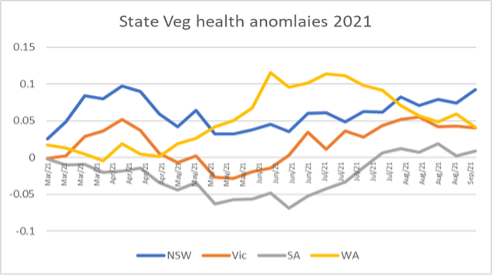Australian Crop Update
FOB replacement values using Australian track bid/offer – not an indication.

We are nearing the pointy end of the Australian season and most cropping regions are looking for rain to maximise yields or hang on to the current potential. The latest NDVI data saw crop conditions improve in NSW, South West QLD and SA. Conditions have remained steady in VIC, however in WA, conditions continue to slide as crops look for rain.

Dry weather in the west, along with talk of frost damage, strength in Black Sea cash markets and the weaker A$ are all offering support for local prices last week in both old and new crop. Looking at the weather models, there seems to be some rain for parts of WA and across SA, VIC and NSW at the end of September/early October. This will be watched closely.
Dry weather concerns and talk of frost damage in WA has most likely limited any further yield growth in WA but it is still a large, albeit likely to be low protein, crop. Our analyst cut WA wheat production estimates by about 5% due to the absence of any significant rain in August and likely September. Production losses in WA will be offset by higher output in NSW, at least for now. NSW veg index levels have trailed last year’s levels through the season after a slow start, but they continue to climb and the gap is narrowing. The favourable conditions and early September justify a 10.75 Mt NSW crop based on an average yield of 2.85 t/ha. This adds another 1 Mt onto the NSW crop from our previous forecast. SA and VIC production will decline without some late September rain.
To receive this information directly to your inbox as soon as it’s released, sign up for our newsletter below.
The post Australian Crop Update appeared first on Basis Commodities.
Share This Article
Other articles you may like
Sign Up
Enter your email address below to sign up to the Basis Commodities newsletter.








